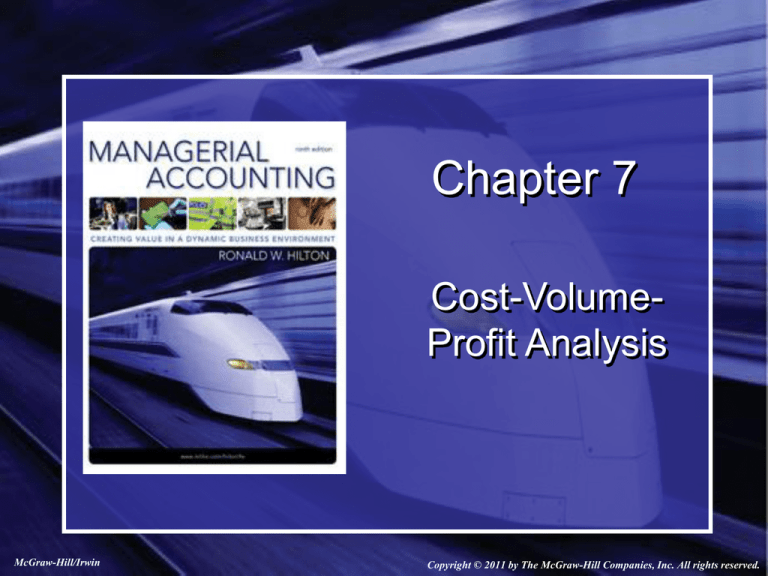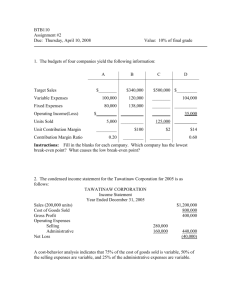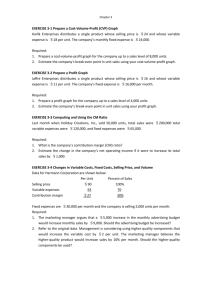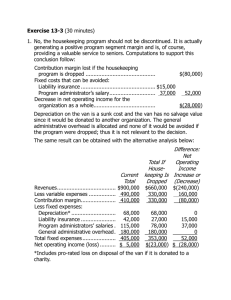
Chapter 7
Cost-VolumeProfit Analysis
McGraw-Hill/Irwin
Copyright © 2011 by The McGraw-Hill Companies, Inc. All rights reserved.
The Break-Even Point
The break-even point is the point in the
volume of activity where the organization’s
revenues and expenses are equal.
Sales
$ 250,000
Less: variable expenses 150,000
Contribution margin
100,000
Less: fixed expenses
100,000
Net income
$
-
7-2
Equation Approach
Sales revenue – Variable expenses – Fixed expenses = Profit
Unit
Sales
sales × volume
price in units
Unit
Sales
variable × volume
expense in units
($500 × X) –
($300 × X)
– $80,000 = $0
($200X) – $80,000 = $0
X = 400 surf boards
7-3
Contribution-Margin Approach
Consider the following information
developed by the accountant at Curl, Inc.:
For each additional surf board sold,
Curl generates $200 in contribution
margin.
Sales (500 surf boards)
Less: variable expenses
Contribution margin
Less: fixed expenses
Net income
Total
$250,000
150,000
$100,000
80,000
$ 20,000
Per Unit
$
500
300
$
200
Percent
100%
60%
40%
7-4
Contribution-Margin Approach
Fixed expenses
Break-even point
=
Unit contribution margin
(in units)
Sales (500 surf boards)
Less: variable expenses
Contribution margin
Less: fixed expenses
Net income
$80,000
$200
Total
$250,000
150,000
$100,000
80,000
$ 20,000
Per Unit
$
500
300
$
200
Percent
100%
60%
40%
= 400 surf boards
7-5
Contribution-Margin Approach
Here is the proof!
Sales (400 surf boards)
Less: variable expenses
Contribution margin
Less: fixed expenses
Net income
400 × $500 = $200,000
Total
$200,000
120,000
$ 80,000
80,000
$
-
Per Unit
$
500
300
$
200
Percent
100%
60%
40%
400 × $300 = $120,000
7-6
Contribution Margin Ratio
Calculate the break-even point in sales dollars
rather than units by using the contribution margin
ratio.
Contribution margin
Sales
Fixed expense
CM Ratio
= CM
Ratio
Break-even point
=
(in sales dollars)
7-7
Contribution Margin Ratio
Sales (400 surf boards)
Less: variable expenses
Contribution margin
Less: fixed expenses
Net income
$80,000
40%
Total
$200,000
120,000
$ 80,000
80,000
$
-
=
Per Unit
$
500
300
$
200
Percent
100%
60%
40%
$200,000 sales
7-8
Graphing Cost-Volume-Profit
Relationships
Viewing CVP relationships in a graph gives
managers a perspective that can be obtained in
no other way.
Consider the following information for Curl, Inc.:
300 units
Sales
$ 150,000
Less: variable expenses
90,000
Contribution margin
$ 60,000
Less: fixed expenses
80,000
Net income (loss)
$ (20,000)
400 units
$ 200,000
120,000
$ 80,000
80,000
$
-
500 units
$ 250,000
150,000
$ 100,000
80,000
$ 20,000
7-9
Cost-Volume-Profit Graph
450,000
400,000
350,000
Dollars
300,000
Break-even
point
250,000
200,000
150,000
Fixed expenses
100,000
50,000
100
200
300
400
Units
500
600
700
800
7-10
Target Net Profit
We can determine the number of surfboards
that Curl must sell to earn a profit of $100,000
using the contribution margin approach.
Fixed expenses + Target profit
Unit contribution margin
$80,000 + $100,000
$200
=
Units sold to earn
the target profit
= 900 surf boards
See the Equation Approach example in text book (LO1)
7-11
Applying CVP Analysis
Safety Margin
• The difference between budgeted sales
revenue and break-even sales revenue.
• The amount by which sales can drop before
losses begin to be incurred.
See example the Safety Margin example in text book (LO4)
7-12
What would happen to BREAK
EVEN POINT if there is a:
• Changes in Fixed Costs: See example in
text book (LO4)
• Changes in Unit Contribution Margin: See
example in text book (LO4) for:
– Unit Variable expenses
– Sale prices
7-13
Predicting Profit Given Expected
Volume
Given:
Given:
Fixed expenses
Unit contribution margin
Target net profit
Fixed expenses
Unit contribution margin
Expected sales volume
Find: {req’d sales volume}
Find: {expected profit}
See the example in text book (LO4)
7-14
CVP Analysis with Multiple
Products
For a company with more than one
product, sales mix is the relative
combination in which a company’s
products are sold.
Different products have different selling
prices, cost structures, and contribution
margins.
See the example in text book (LO5)
7-15




